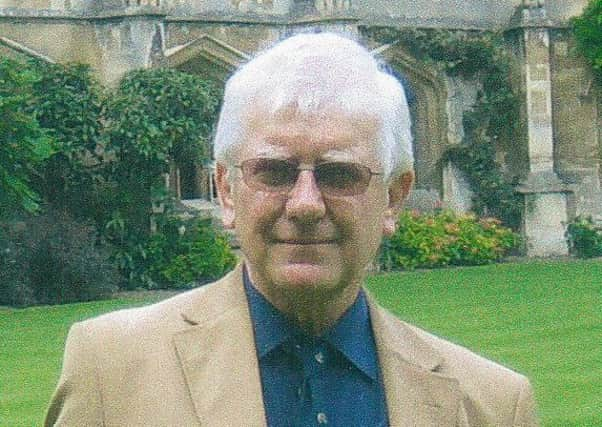Obituary: Anthony Goodman, Edinburgh University professor of history


Scotland’s capital has always been a great vantage point from which to keep an eye on the English, and it certainly proved so for Edinburgh University’s Professor Tony Goodman, the historian.
His works on England’s Wars of the Roses, its prince John of Gaunt, and its history from Richard II to James I, all written in the shadow of Edinburgh’s Castle Rock, are now standard texts.
Advertisement
Hide AdAdvertisement
Hide AdAn internationally acclaimed scholar, with expertise also on medieval Spain and its relations with England, Goodman might be considered, as well, the equal of Sir Walter Scott in his fascination with and scholarship of the culture of the Borders.
In a 41-year academic career at Edinburgh from 1961, retiring as Professor of Medieval History, the London-born Goodman brought to life the careers of several women of the late Middle Ages.
He continued, in retirement, from 2002, to teach PhD students, and went on writing. His final book, finished not long before his death, is to be published early next year and shines light on Joan, the Fair Maid of Kent, wife of England’s 14th-century Black Prince, who is seen as the first English Princess of Wales.
Goodman’s students, many of whom have gone on to hold senior positions at universities, remember their studies being inspired by the many expeditions he took them on to churches, castles, and other sites where controversies had raged five centuries before.
The citizens of Edinburgh also took pleasure from his work expounding the secrets of the city’s medieval chapels including St Triduana’s Aisle, Restalrig; St Anthony’s Chapel in Holyrood Park, and the Magdalen Chapel, Cowgate. After one such tour, which he led to raise funds for charity, the gathered enthusiasts declared: “Tony’s team walked the walk.”
The research that won Goodman his first lectureship at Edinburgh was into medieval parliamentary representation, and he did it after completing a degree in history from Magdalen College, Oxford, taught by the noted medievalist Kenneth Bruce McFarlane.
It was in Edinburgh that Goodman met his future wife, Jacqueline Hawkes, always known as Jackie, and they married in 1964. They were to have a daughter, Emma. She, with his wife, survives him.
Few were aware that Goodman’s painstaking studies of books and difficult-to-read half-thousand-year-old manuscripts were undertaken against a handicap that arose from an operation done in his childhood to try to correct a “lazy eye”, and that might have daunted lesser spirits: permanent double vision. This he mastered with the help of glasses, and determination.
Advertisement
Hide AdAdvertisement
Hide AdA man known for his gentle humour, Goodman never wavered in his enthusiasm for his subject, and always carried with him a small notebook and a pencil-stub to jot down ideas. He lectured in England, the United States, and Spain, and is remembered for quickly memorising enough Spanish to deliver a learned paper in the language.
He was alert to historical parallels: dilemmas, experienced by noble personages under the “tyranny” of the English king Richard II in the late 14th century , which Goodman describes as “confrontations…with manifestly unjust orders and acts”, were, he reflects, in the introduction to his first book, The Loyal Conspiracy (1971), “of a sort unhappily familiar to 20th-century Europeans.”
Of 21st-century Scots and English political questions, it is recalled that “he worried a little about the future of Scotland.”
An early riser, he liked to read in his study. In later years, having amassed research from travels around England and Spain, he had many chests full of notebooks.
Amid apparent haphazardness, he was able from memory to lay his hands on the right material needed.
He once vouchsafed that he was fascinated by the Georgian period of the 18th and 19th centuries, but had somehow moved backwards.
He could be, some have reflected, “a bit of an Eeyore”, but always responded to efforts to cheer him up. Very modest, and not given to bandying his professorial title about, he had a quiet but strong religious belief.
Anthony Eric Goodman was an only child, the son of an architect, and attended Selhurst Grammar School in Croydon, Surrey, from where he was the first pupil to win a place at Oxford. He had been brought up in the Church of England, but converted to Roman Catholicism, his wife’s faith, when he married.
Advertisement
Hide AdAdvertisement
Hide AdAs respite from sitting over his books, he enjoyed walking, and loved Northumbria, the border English county that – as he explains in A History of England (1977) was once one of the three English “Wardenries” facing Scots counterparts in the East and West Marches from the 14th century until the 1603 Union of the Crowns.
These parts, Goodman notes, were re-named “The Middle Shires” by James VI of Scotland and I of England after his accession to the throne, and were, in the king’s words, “now become the navel or umbilic of both kingdoms, planted and peopled with civility and riches.”
Goodman’s account of James’s address to parliament in 1604 even suggests a prefiguring of Brexit: the island of Great Britain, the king declared, “is now become like a little world within itself.”
ANNE KELENY